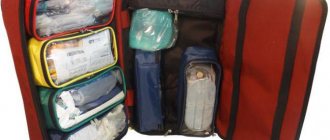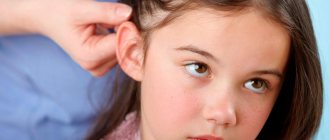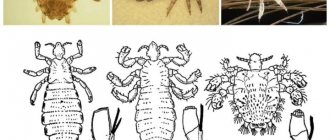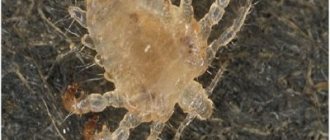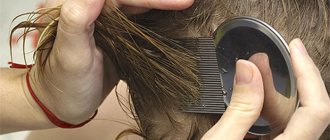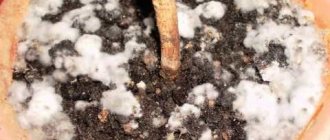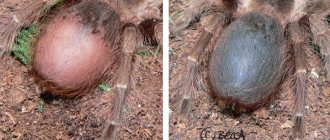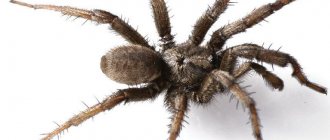What to do if there are lice at school: what to do
If you yourself discover uninvited tenants on your child’s head, do not panic. First of all, you need to understand that head lice is a problem that does not depend on hygiene and social status. Lice absolutely don’t care whether a child’s hair is clean or dirty, what brand of shampoo he washes his hair with and how often. If there are lice at school, then all children have the same risk of becoming infected. Therefore, do not be nervous - your mood may confuse or upset the child, but he is not to blame for anything.
The first thing to do is to notify the class teacher and the school nurse. If your child goes to clubs or sports clubs, you should notify their leaders. After this, it is necessary to carefully check the heads of all family members and begin treatment.
Lice are insects that require certain temperature conditions and nutrition to survive. Therefore, they cannot survive without a host. In one study, scientists checked the surfaces of desks, chairs and floors in a classroom with an outbreak of head lice. No live insects were found. This means that during treatment you do not have to do a complete sanitization of the apartment.
Modern anti-pediculosis agents help effectively combat both lice and nits, which makes treatment quick and effective.
How to protect your child from lice at school?
No matter how tidy your child is, he is at risk of getting lice. Especially if you are in junior or middle school.
The fact is that in the summer many schoolchildren relax in children's camps and dachas, from where they often return with such a nuisance as lice.
And if parents do not notice this in time and do nothing, children carry a blood-sucking army of parasites on their heads to school and infect their classmates with them. The appearance of lice often causes panic among parents. But let's put aside the panic! Let's learn to take action in advance!
What you need to know about head lice?
Head lice infestation (doctors call it “head lice”) has nothing to do with personal hygiene. Even the most inveterate cleaner can develop blood-sucking parasites that cause a lot of trouble.
99% of infections occur through direct contact “head to head”, so the main risk group are children who, at their age, are very close contacts, especially during joint games.
Once on the head, lice begin large-scale work: they not only bite, but also actively reproduce. Lice eggs (nits) are attached to the hair with a special sticky secretion and wait to mature. In a word, even if you catch a spotted louse and deal with it, this does not mean that after a few days its offspring will not continue the “lousy” business.
Prevention of pediculosis: how to prevent infection?
In order to avoid infection with head lice, it is important to follow simple rules of prevention:
- during outbreaks of head lice (period of increased danger - summer and the first 2-3 weeks after the holidays), regularly examine the child’s head;
- If your child is infested with head lice, notify the class teacher and the parents of the children with whom your child most often interacts. The main thing is to examine all children as quickly as possible and get rid of lice if they are found. Thus, the chain of transmission of lice from child to child in a children's group is broken.;
- Make sure that your child always has a neat hairstyle: boys are recommended to wear short haircuts, girls should wear long hair in braids;
- Use products to prevent head lice at home.
How to choose a product for the prevention of pediculosis?
Today, the choice of means to prevent head lice infection is, alas, small. Among the repellents is one developed using special technology, providing protection for up to 24 hours.
The repellent contains a special ingredient IR3535, which repels adult parasites and prevents them from laying new eggs. The drug is recommended for use during “dangerous” periods - in the summer and in the first weeks of school after the holidays. Paranit Repellent is suitable for daily use by adults and children over 3 years old.
Who needs to use Paranit Repellent “Protection against Lice”?
A remedy for the prevention of head lice will help:
- For elementary and middle school students at the beginning of the school year: the repellent will help prevent them from catching lice from classmates returning from vacation;
- For children treated for head lice: using repellent will help avoid re-infection in the school environment;
- For parents of a child who has lice: the repellent will prevent the spread of lice within the family while the child is undergoing treatment.
How to apply repellent correctly?
For Paranit Repellent “Protection against Lice” to work effectively, follow the instructions for use:
- apply the repellent to clean, dry hair, after combing it or styling it;
- spray the product onto the entire surface of the hair from a distance of about 20 cm, paying special attention to the back of the head and the area behind the ears;
- depending on the thickness and length of the hair, apply 20-25 sprays;
- After application, do not use a hairdryer - let your hair dry naturally. The product dries on the hair quite quickly;
- Treat your hair with Paranit repellent daily and after each hair wash during outbreaks of head lice, as well as after treatment with lice products to avoid re-infection.
Source: https://lib.komarovskiy.net/kak-zashhitit-rebenka-ot-vshej-v-shkole.html
Where to report if there are lice in the classroom?
As mentioned above, you just need to notify your class teacher and school nurse about the problem. They, in turn, must notify the parents of all children in the class and ask them to take action. If the problem is not resolved, you can file a complaint with the school administration.
Many parents do not fully understand how head lice is localized at school. They imagine it this way: the institution is closed for quarantine and a total sanitary treatment of the premises is carried out. Therefore, complaints should be addressed first of all to the SES.
Today, such a structural unit as the SES does not exist. Her duties are carried out by Rospotrebnadzor, which monitors the implementation of anti-pediculosis measures in schools. According to current sanitary standards, during an outbreak of lice, floors, furniture and walls cannot be treated. Only mats in school gyms are treated. Therefore, the main responsibilities for preventing the spread of infection fall on the shoulders of parents. Each of them is obliged not only to remove their child, but also to make sure that the treatment was effective and the possibility of recurrence of head lice is excluded.
What happens in practice?
In reality, the problem of lice falls entirely on the shoulders of parents, who must deal with lice on their own. Having discovered directly from your child or learned from other parents that lice have appeared at school, https://vk.com/club_razvivajka every adult should first take measures to destroy them and try to protect their student from possible infection from other students in the class.
Sequence of actions to destroy pediculosis (memo for parents):
- buy lice treatment at the pharmacy;
- treat the child’s head and hair according to the instructions of this product;
- wash your hair thoroughly with regular shampoo; in emergency situations, boys can have a “zero” haircut;
- mechanically comb out dead insects and nits, for which they often use a special comb and a vinegar solution, then rinse the hair with water;
- wash all personal belongings and bedding of all family members;
- examine other people living in the house and, if found, take measures to remove lice;
- report the situation to the nurse at school, after which the educational institution staff must carry out a set of anti-pediculosis measures;
- carry out several inspections every week and, if found, repeat the treatment for your child and the whole family until the insects and their eggs are completely destroyed.
Is it possible to go to school with head lice?
No. If your child has been found to have lice, he does not have the right to attend school until they are completely eliminated, which is confirmed by a certificate from a dermatologist. This approach outrages many parents: not only did my child catch lice in class, he now also has to miss classes. But in practice, not everything is so scary. Modern pediculicides can get rid of the problem in just one treatment. As for nits, empty (or dead) lice eggs are not a barrier to school attendance. The main thing is that at the time of examination the child does not have live lice or nits.
How to withdraw?
If parasites are found in a child, parents need to take timely measures to destroy them. The main thing is not to panic, be patient and calm.
Diagnosis of pediculosis usually does not cause difficulties, but to establish an accurate diagnosis and prescribe treatment, you can consult a doctor.
Mechanical and chemical methods are used to remove lice and nits. Pharmacies offer a wide selection of repellents that allow you to quickly get rid of parasites. You can use shampoo, spray or lotion “Paranite”. It contains a complex of mineral oils, it is non-toxic and absolutely harmless to the skin and respiratory organs.
Hellebore water is also used to treat pediculosis. It is used in combination with combing with a special comb and observing safety precautions due to toxicity.
All residents in the house must be carefully examined and, if detected, appropriate treatment measures must be taken. Such examinations must be carried out weekly until complete recovery.
Be sure to organize washing of the infected person’s personal belongings and the whole family’s bed linen. Hats, combs, hairpins and towels need careful processing.
If they independently discover lice on their child, parents are required to inform the school paramedic or class teacher. There is no point in hiding and hushing up the infection in such a situation; this can lead to the further spread of head lice among school students.
Employees of the educational institution, in turn, must take measures to prevent the growth of the disease.
Quarantine for head lice: when is it introduced, how long does it last?
If lice are found on two or three children in a class, no quarantine measures are required. In the event of a mass outbreak of the disease, the nurse is obliged to notify Rospotrebnadzor. Each case of parasitic diseases is registered in the register of infectious diseases at the place where they were detected.
Quarantine for head lice is introduced for 30 days. During this period, schoolchildren continue to attend classes. Quarantine measures consist of weekly checks of students for lice and live nits. A more strict quarantine, which includes preventing schoolchildren from attending classes, is possible if outbreaks of head lice are recorded in several classes of the school.
Pediculosis epidemic in kindergarten - where to complain?
If, at the request of parents, the kindergarten administration does not take appropriate measures to eliminate the outbreak of head lice, it is recommended to contact the district or city SES. Specialists are required to visit a preschool institution, identify parasitic infestations and take action.
https://www.youtube.com/watch?v=https:accounts.google.comServiceLogin
The source of pediculosis infection requires special attention, since incorrect or untimely preventive work can lead to a new wave of the disease
This problem is given special attention at the state level
Certificates for pediculosis: where to get?
After a case of lice in a child is recorded by the school nurse, he is suspended from classes and can return to school after complete recovery, confirmed by a doctor’s certificate. Please note that such certificates have a very short validity period - only 3 days. Therefore, if, after passing the test, the child for some reason is unable to come to school within the specified period, the certificate will have to be taken again
The document is issued by a pediatrician. He carefully examines the child's head for lice and live nits, and, if everything is in order, makes the appropriate mark on a special form. If lice are found during the examination, the doctor will give recommendations on the correct treatment.
Symptoms of lice
Symptoms of lice in a child
symptoms
- constant itching in those places where lice have infested; with head lice, there can be especially many of them in the area above the ears, in the temporal and occipital parts of the head;
- the appearance of red spots on the skin that remain after lice bites;
- specific gray-blue spots that appear from secreted enzymes after the louse's proboscis is inserted into the skin;
- in an advanced stage, ulcers may appear in places where scratching occurs when infection penetrates there, which will have to be treated additionally.
If you do not notice in time that a child has lice on his head and do not begin to destroy them, then ulcers under the hair may develop and, as a result, pyoderma.
Some children may experience a specific body reaction to the presence of lice in the form of an allergic rash, high fever, headaches, nausea and vomiting. This is usually caused by the penetration of enzymes secreted by insects into the blood.
SanPiN for pediculosis
SanPiN is a document that describes sanitary and epidemiological rules and regulations for the prevention of parasitic diseases on the territory of the Russian Federation. It establishes the requirements for organizational and sanitary and anti-epidemic measures aimed at preventing the occurrence and spread of parasitic infections.
In accordance with the current SanPiN for pediculosis, measures to prevent the disease include:
- 1. Routine examinations of various population groups (schoolchildren should be checked every month)
- 2. Providing extended day groups of junior classes with replacement bed linen.
- 3. Suspension of students from attending school if head lice is detected, with the opportunity to return to classes after completing a set of treatment and preventive measures with a confirmatory certificate from a pediatrician.
- 4. Observation of persons in contact with a person with lice for 1 month and checks for lice once every 10 days.
These measures, combined with the organized actions of parents, are quite enough to prevent the spread of head lice.
What must a kindergarten do to prevent head lice?
The spread of head lice in preschool institutions is due to the fact that a child under 7 years of age has not yet mastered the complex of independent hygiene. A large gathering of small children leads to lightning-fast infection.
In kindergartens of all types, preventive measures must be carried out. The regulations establish the following procedure:
- Conducting scheduled conversations and briefings with parents as part of the parent meeting. On the agenda are the main methods of prevention and ways to combat the disease.
- Examination of a newly arrived child by a regular health worker. If parasites are found, the child is not allowed into the institution. After treatment, the child’s parents must provide an appropriate certificate from the clinic indicating complete recovery.
- Routine examination of children is carried out at least once a month. Data from the examination of pupils is recorded in a special journal. Patients are sent for treatment.
Removing lice is a serious problem, especially if the case is advanced. This is due to the fact that almost all products are designed to destroy adult parasites, and only a few kill nits (the so-called larvae attached to hairs in a cocoon). Medicines for head lice are considered the most effective, in contrast to traditional methods.
Complex treatment is the only correct way to deal with lice. In addition to special shampoos and lice combs, it is necessary to purchase products for washing and disinfecting the child’s personal belongings and hygiene items. The most popular are:
- Hygia is a pediculocidal shampoo. There are contraindications - age under 2 years.
- Pedilin is a universal remedy. Available in the form of gel, shampoo and emulsion. Can be used to treat childhood lice.
- Nittifor is a gel used for the prevention and extermination of parasites.
- Para Plus Spray is a preventive preparation for treating bed and underwear.
In addition to medications, traditional methods are often used, including treating the hair and scalp with vinegar or hydrogen peroxide.
Processing is carried out in several stages. This is done to minimize the reappearance of nit insects. It is recommended to comb out the eggs daily using a fine-toothed comb (most often it is sold complete with shampoo). The main condition for successful treatment is the detection and combing out of all larvae.
Bed linen and clothes are washed using a pediculocidal drug or boiled. Heat treatment with iron is possible. There is an opinion that it is enough to remove things that the child has come into contact with for several days. The fact is that lice outside the human body can live a little more than a day, and larvae much longer.
How should a school inspection be conducted?
According to the results of epidemiological studies of group morbidity in school institutions, one of the main reasons for outbreaks of head lice are irregular and insufficiently high-quality examinations of children by school nurses. In addition, many schools often ignore the month against head lice, which traditionally should be held in September. Neglect of preventive measures on the part of school institutions leads to children bringing lice from home, after which the infection rapidly spreads among students throughout the school
Examination for lice should be carried out in a well-lit room with a magnifying glass and a fine-tooth comb. After each examination, the nurse should clean the comb with an alcohol solution. Inspections must be carried out after each holiday, as well as monthly on a sample basis: 4-5 classes from the school.
Lice in school, who should I complain to? ()
A child brought lice from school. I informed the teacher, it turned out that someone had it about a month ago, but they didn’t tell anyone. Two weeks ago the children were checked and nothing was found. To whom and how to report correctly? Answer
Well, it’s better to go straight to the presidential administration. Answer
I will support you. Contacting the presidential administration is very helpful in the fight against lice. Answer
Scoff, scoff. and I don’t want children (not just mine) to get infected from each other in a circle. I just don’t know who is the right person to contact in such a situation so as not to be hushed up Reply
If I knew, I would definitely look through it. The child began to complain of itching in his head, at first there was nothing visible, I thought it was an allergy to the new shampoo. And when it didn’t go away, nits appeared at the roots and in places “hidden” to the eye. Now we’ll look around like monkeys Reply
eva.ru
Prevention of head lice at school: a reminder
Preventive measures to prevent the spread of head lice in school settings include:
- • Compliance with personal hygiene measures: the child must wash regularly, change underwear and bed linen. It is also necessary to systematically clean outer clothing.
- • Parents should regularly inspect their child's head for lice and nits.
In addition, parents should explain to children that it is important to avoid close contact with other children, especially if there is an outbreak of head lice at school.
Who is to blame for the spread of lice throughout the school?
For most families, the news of lice at school comes as a complete surprise and causes a storm of indignation. How did this happen? Who is guilty? It is the teaching staff that often becomes the object of such accusations. But neither the principal nor the teachers are interested in the spread of head lice among students.
The source of the disease is a person, that is, infection can occur in a swimming pool, on a playground, even in a shopping center. Determining where it happened and who got sick at school first is a rather difficult task.
Mutual reproaches between parents and schools are inappropriate in this situation. Each party must pay attention to its responsibilities and act together.
The school nurse, teachers and class teachers should conduct conversations and extracurricular activities to inform students about head lice, and organize preventive examinations.
In families, tell children about the causes and consequences of lice infestation, precautions and the need for personal hygiene. It is the parents, with careful attention to the child, who can notice the onset of the disease and take the necessary measures for treatment.
Traditional methods of treatment if you still become infected
There are many ways to combat head lice with products that can be found in any home. The most popular of them are:
- • Essential oils. The scent of many essential oils repels lice. To combat lice, you can use tea tree oil, eucalyptus, and lavender. However, remember that essential oils cannot be used in their pure form: they are added to shampoo.
- • Apple vinegar. This is a good remedy that helps get rid of not only lice, but also nits. Vinegar weakens the sticky substance that female lice use to attach nits to the hair shaft. For treatment, vinegar is diluted with water in a 1:1 ratio.
- • Garlic. It is believed that the specific smell of garlic repels lice. To prepare the mixture, crush 10 cloves of garlic and add 2-3 teaspoons of lemon juice to the paste. The mixture is applied to the hair for half an hour, after which it is washed off with water.
- • Mayonnaise. This method of treatment is based on the fact that the thick sauce deprives the insects of oxygen. Mayonnaise is applied to the hair for about an hour, after which it is necessary to thoroughly wash the hair with shampoo.
The undoubted advantage of treating lice with home remedies is that they are generally simple and cheap ways to combat parasites. However, they also have a significant disadvantage: in most cases, treatment is ineffective and comes down to mechanical removal of live insects and nits.
What to do if a child has lice on his head?
So, you find lice on your child - what to do? First of all, you should calm down and take a sober look at the situation. Lice are just harmless parasites that are very easy to remove.
Read more about the types of lice, how they reproduce, and the incubation period on our website.
If you are constantly being monitored by doctors, then feel free to go to a specialist for diagnosis and treatment of head lice in your child. The main condition in this situation is to follow all the doctor’s recommendations.
If you trust your health and your loved ones to folk recipes, then you can start making medicinal masks and baths. In this case, kerosene masks, rinsing your hair in vinegar water, hellebore water, as well as the use of essential oils (tea tree oil), laundry and tar soap are perfect for you.
It is also worth understanding that lice are parasites that spread very easily and require comprehensive and close attention. Therefore, in addition to folk remedies, our website also contains descriptions and instructions for the use of some other pharmaceutical products suitable for children: sprays for lice and nits - Nyuda, Paranit, Pediculen Ultra, as well as anti-lice ointments: Benzyl benzoate and Sulfuric.
In addition to removing parasites from your skin and hair, thoroughly disinfect all household items and pastels. What is the best way to disinfect?
If we are talking about things and bedding made of fabric, then you can simply wash them at high temperature and carefully iron them.
At higher degrees, the parasites will be destroyed the first time. Disinfection is necessary for combs, hair accessories and other personal hygiene products.
In this case, chemicals are used that can kill all lice. It can be spray, powder, gel or liquid. There are also means to repel parasites. They should be sprayed onto the entire body, clothing, or places of frequent residence.
IMPORTANT! The most important and mandatory condition is mechanical combing, which allows you to get rid of 95% of lice and nits on a child’s hair. Combing is a must! Using a special comb, you get rid of parasites and their derivatives
Thereby protecting yourself and your loved ones from re-infection.
Of course, if you have the opportunity, then it is best to completely get rid of objects with which the infected person has been in contact. If you have a large family, then you need to examine all members, and also isolate healthy ones from the infected family member as much as possible. It is also necessary to develop a set of preventive procedures for the family.
"Paranite": an effective way to get rid of lice
"Paranit" is a line of pediculicides of the latest generation. They contain dimethicone and mineral oil. These components are classified as low-hazard substances and are currently actively used in the production of cosmetics and hygiene products. The action of Paranit products is based on the fact that the active ones clog the respiratory openings of lice and nits, effectively destroying them after the first treatment.
The main disadvantage of most pediculicidal products is that lice become resistant to the toxic substances in their composition. “Paranitis” affects insects physically, so the effectiveness of treatment does not decrease even with repeated use of the products. Another advantage of Paranit pediculide products is that they can be safely used to treat children from 1 year of age and pregnant women (Paranit Sensitive). For parents of schoolchildren, Paranit products can be an excellent solution to the age-old problem of head lice outbreaks.
We fight lice with traditional methods
Best suited for this purpose:
- weak vinegar solution;
- dust soap;
- cranberry juice;
- a mixture of kerosene and vegetable oil;
- hellebore water;
- oxygen peroxide;
- decoction of pine needles, tansy and wormwood;
- a mixture of kerosene and laundry soap;
- vodka or alcohol.
If the child is one year old, what should I do? Can lice cause a lot of harm? The simplest and most radical way to combat these parasites is a haircut to zero.
Kerosene also works well, but this substance should be used with extreme caution. As you can see for yourself, there are many ways to get rid of lice from a child.
What to do at home is up to you.
Preventive agents
The most radical and effective means of combating head lice is still the mechanical method, that is, shaving the head. However, for ethical reasons, this option is not suitable for everyone. Therefore, it is worth considering all possible options and, after consultation with a dermatologist, choose the most suitable one. Usually, all means to combat pediculosis are also used to prevent the disease.
The most effective way to combat head lice is shaving your head.
Table: pharmaceutical products for the prevention of pediculosis
| Release form | Drug name | Features of application | Notes |
| Shampoo | "Nit-Fries" | We use it 2 times a month. | Created based on natural ingredients. But due to its oily structure, it is difficult to wash off from the hair. |
| "Knock" |
| Used from 2.5 years of age, during pregnancy and breastfeeding. | |
| "Pediculen" |
| Available in the form of shampoo, spray conditioner, lotion. Shampoo is used for prevention, lotion and spray for treatment, and in combination with a comb for combing. | |
| "Lavinal" (shampoo or spray) |
| Used for children from 2 years old. | |
| "Veda", "Veda-2" |
| We use it once every 7 days for 2-3 weeks after contact with the patient. | |
| "Paranite" |
| ||
| "Hygia" | The permethrin included in the composition penetrates deeply into the hair structure. However, the unpleasant smell of the product can be annoying. | ||
| "Nittifor" | The consistency is similar to lotion.
| A very aggressive drug that is rarely used for prevention. If there are scratches or rashes on the skin, then you should not use it. | |
| "Sumitrin" |
| Can be used from 2 years of age. An allergy test is required. | |
| "Nuda" | Used only for prevention. And if there was contact with an infected person, then it is better to choose something more effective. | ||
| Soap | "Dez-F" | Can be used for disinfection of premises and clothing. | |
| Spray | "Nit-Fries" | Apply to hair, especially to the back of the neck, crown area and behind the ears. You can process hats and pillows. | Available in two versions: with menthol or rosemary flavor. |
| LiceGuard | Can be used every day, including before styling. Protects for 24 hours. | Does not contain chemical components. |
Table: folk methods of protection against pediculosis
| Means | Features of application | Notes |
| Tea tree oil and lavender essential oil | Mix in equal proportions, add 5 parts of water, apply to the roots, wrap your head in cellophane and wash off after 50 minutes. | You can repeat the procedure weekly. |
| Lemon, geranium, mint, ylang-ylang, anise, peppermint, rosemary, clove, eucalyptus oils | Add 5 drops of any of these oils to shampoo. | We use enriched shampoo once a week. The most acceptable way to prevent head lice in children. |
| Hellebore water | Apply to washed hair over the entire length. After 30–40 minutes, rinse with warm water. | Can be used by pregnant women, women during lactation and children. It is considered the most effective folk method. |
| Vinegar | Rinse your hair after washing by diluting the vinegar with water 1:1. | Your hair will become shiny. True, the smell will not be very pleasant. |
| Cranberry juice | Grind 2-3 handfuls of berries with 1-2 tsp. honey. Apply to dry hair, leave for 30 minutes, rinse with warm water. | The acid prevents nits and lice from clinging to the hair. |
| Dust soap | Apply to damp hair, put on a swimming cap for 30 minutes, and rinse with regular water and shampoo. | Very pungent smell. It is not recommended to use soap too often, 1-2 times is enough. |
| Tar soap (the product is also available in the form of shampoo) | Apply to damp hair for 30–40 minutes. | Soap has no effect on nits. |
Tar soap is effective only if the louse has not had time to lay nits, otherwise you will have to use this hair-aggressive product for a long time
Treatment of pediculosis in a child with folk remedies
Not all parents go to the pharmacy to buy a remedy for head lice; most often, this is dictated by the desire to choose the least dangerous remedy for their child’s health.
Essential oil
Foreign studies on the effectiveness of essential oils for killing nits and lice have shown the following results:
- Oregano, anise and cinnamon - kills 100% of adults and nits;
- Tea tree (Melaleuca) - 83% nits, 93% adults.
The most effective method of application is to use a high concentration of essential oil in alcohol (alcohol makes the chitinous cover of insects more permeable to the properties of essential oil insecticides):
Rub 50 ml of alcohol (vodka) 10 drops of essential oil (for example anise) into the scalp and hair, put on a shower cap and leave overnight. Then the solution should be washed off with shampoo, and then rinse your hair with the following solution: 2 ml of essential oil, 50 ml of apple cider vinegar (9% table vinegar can be used) and 50 ml of water. After rinsing, you need to comb out strand by strand with a comb. Treatment should be repeated after 7 days; between treatments, be sure to comb your hair daily.
Salt (sea, iodized or regular table salt)
One of the simplest, but no less effective solutions for the treatment, as well as for the prevention of head lice in children, is ordinary salt. It can be used either alone or in combination with vinegar (apple or table vinegar 9%). Salt and vinegar work great together to dehydrate and kill lice and nits.
Salt can be rubbed into the hair and scalp for 1-2 minutes (be careful not to injure the child’s skin), put on a shower cap and leave for 3-4 hours, then rinse with water, comb the hair thoroughly, repeat the procedure for 2-3 days in a row. To consolidate the result, the procedure is repeated after 5-7 days.
Salt can also be sprayed or poured onto clean, damp hair and scalp (1/4 cup salt dissolved in 1/4 cup warm apple cider vinegar), do not rinse, wait until hair is dry and apply coconut oil to scalp and hair. or Vaseline. Leave the oil on overnight to smother any remaining living lice. In the morning, wash your hair and comb it.
Other effective and efficient folk remedies
There are many other ways to get rid of lice at home.
| A drug | Mode of application |
| Table vinegar (9%) | Dilute with water 1:2 and apply to hair overnight. Not recommended for severe scratching and sensitive skin. |
| Coconut oil or Vaseline | At night, apply to hair roots and put on a shower cap. |
| Freshly squeezed pomegranate or cranberry juice | Apply at night under a cap and towel. |
| Mint and pomegranate decoction | Pour a couple of large spoons of mint into 220 ml of pomegranate juice. Heat to a boil and simmer over low heat for ten minutes. Cool the composition and rub into the hair roots. Leave for half an hour, then rinse your hair with shampoo. This procedure must be repeated every five days. |
| Angelica and bird cherry ointment | Combine a mixture of plant root powders with any oil in equal parts. Apply to the scalp, keep for half an hour under a cap, then rinse. |
Tar soap is good against lice. But it dries out the scalp and increases hair fragility.
Treatment at home is widely available and, with the right approach, does not harm health, but it will take more time than using pharmaceuticals.
Combs for lice and nits
It doesn’t matter whether you use pharmaceuticals or folk remedies for lice in children, after treating the hair, it is imperative to comb the child’s hair, over the bathtub or on a white sheet, to remove dead parasites and their larvae. For this you need a comb with fine teeth. A regular comb will not work in this case, since its teeth are located far from each other, and it will be difficult to remove parasites from the hair.
For this you need a comb with fine teeth. A regular comb will not work in this case, since its teeth are located far from each other, and it will be difficult to remove parasites from the hair.
Comb for lice and nits
For these purposes, a wooden, plastic or metal comb is usually used. Of the modern combs, the most popular are combs from the AntiV and Nit free brands. As you can see in the photo below, the teeth of the comb are so close that they will not allow parasites to pass through. Before using the comb, the child’s hair must be rinsed from the preparation, apply hair conditioner, which will make combing easier, comb the child’s hair with a regular comb, then comb it strand by strand with a special comb.
It should be noted that many pharmaceutical preparations are already equipped with similar combs, as well as a magnifying glass, for a more thorough check of the child’s hair.
Memo for parents on the prevention of head lice
This is the name of the information sheet, which reveals the basic concepts regarding the disease: causes, symptoms, methods of treatment, features of the life of lice. It may contain pictures on the topic of parasites, infection, and hair habitats. If you have an idea of what lice are, you can avoid infestation. These are ectoparasites that crawl from one person to another. This is how they spread. Insects feed on human blood and lymph fluid. They live on the head and are here all the time: when they are awake, they feed, they reproduce.
There is body lice, but this type of disease is more common under unfavorable conditions: in large groups, where people do not always follow the rules of hygiene, and there is also a low cultural and social level of society. Head lice in children in kindergarten is diagnosed much more often. Moreover, the cultural and social level of development of society does not play a special role, since the method of transmission of lice is simpler - it is enough to touch the hair of an infected person, for example, in public transport or at a concert, as well as preschool and school institutions, as a result, the insects will have time to crawl to a new sacrifice.
The average lifespan is indicated, since the lifespan of lice depends on environmental conditions and can increase as well as decrease. Every day, adults lay 4-6 eggs, and sometimes more - up to 10 eggs. The duration of development of the embryo inside the shell is up to 7 days. It then takes about 2 weeks for the larva to develop to the mature stage. After this, the parasites begin to multiply. This leads to an increase in the intensity of symptoms:
- the child begins to complain of severe itching;
- obsessive movements appear because the head is very itchy;
- dermatitis develops, this pathological condition is accompanied by peeling, hyperemia, and rash;
- traces of bites are visible on the skin: swelling with dried blood in the center;
- nits are found, adult lice are found near the outer integument (at a distance of 1-2 cm above the outer integument);
- the child may feel movement on the skin;
- irritability appears, which is due to deterioration in the quality of sleep, children often become aggressive, the level of attentiveness and mental performance decreases.
Preventing the development of pediculosis is only possible if hygiene rules are followed. It should be noted that children cannot always independently control the quality of hair washing or the cleanliness of the hair accessories and hats they use. For this reason, adults should study the causes of infection in order to monitor the condition of children's heads:
- physical contact, lice are often found in kindergarten, as children constantly touch their hair while playing;
- using other people's things: hairpins, combs, hats, towels and others;
- visiting a pool, swimming in a pond with stagnant water (here a child can pick up parasites and then bring them to a preschool);
When infected, complications sometimes develop. For example, children develop allergies. Diseases and pathological conditions that may develop:
- sepsis;
- typhus;
- lymphadenitis;
- blepharitis;
- conjunctivitis.
If lice is discovered in kindergarten, preventive measures are as follows:
- limiting physical contact with infected people;
- regular inspection, at home parents should check the head every 5-7 days, if lice are found in the garden, then this should be done more often - 1 or 2 times every day;
- careful hair care: the head should be washed as it becomes dirty, the hair should be cut regularly;
- treatment with essential oils: apply 1-2 drops of the substance to the hair or prepare an aqueous solution based on it; spray the hair with this product using a spray bottle;
- They use special elastic bands (a preventive measure for girls) containing capsules with essential oils; they do not absorb moisture and continue to act for 10 hours.
Signs of lice in a child
Allergic reactions in children
Download the memo
To take a closer look at the information sheet, you can download it and read it at home. This will allow you to periodically return to the information you have read if signs of head lice appear and stop them.
PEDICULOSIS IN CHILDREN: MEMO FOR PARENTSDownload


